Hello dear readers. This blog will detail my travels to the city on the Volga, better known by its Soviet name Stalingrad. Diogo and I were invited to attend Volgograd State University’s Model United Nations conference by their head delegate Angelina Pivovarova (love that her last name means “brewer”). Angelina is a very nice girl and Diogo and I made friends will her very quickly while she was with us in Pyatigorsk for our Model UN. We were so lucky to be invited to their conference. It was interesting to learn that Volgograd State University’s Model UN is totally run by the students, making it a very nice event to both mingle and work. Diogo and I bought a train ticket to Volgograd and “enjoyed” the 18 hour ride to the city from Pyatigorsk (as a side note, I would say that the ride was a mix between the comfort of the sitting in a movie theater and the discomfort of an Amtrak train in the U.S.).
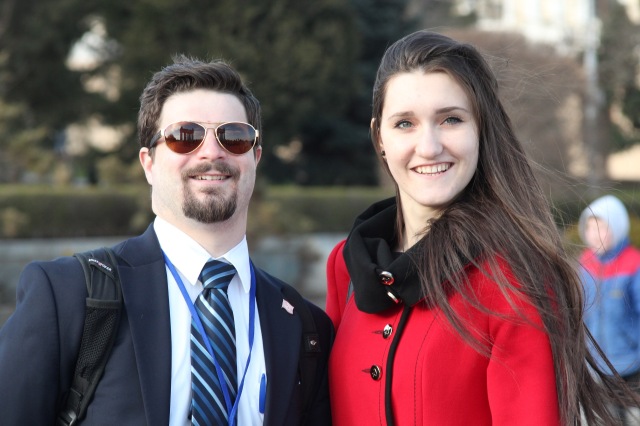
When we arrived in Volgograd, we got to see the famous Volgograd Train Station, with it’s “lovely” Soviet Era architecture. To be very honest, Volgograd isn’t the prettiest city. During the War, the city was completely destroyed and thereof needed to be rebuilt. Volgograd personifies post-Modernist and Soviet style building, making it grey and very Communist. This being said, the city has very impressive monuments to the Second World War. The events of the war decided the fate of the city and it is a physical representation of the historical memory that the Russians have concerning the War. It is both a blessing and a curse, a blessing in that it is a way to learn about the history of their nation, the War being a definitive moment for the Russian people (much like the Battle of Borodino). It is a curse because it seems like they can never “move on” from this event. One of my German peers at the conference, recalled while walking in the street, he was accosted by Russians. He was speaking German on his cell phone and passer by’s heard him. They said things, like “We won the War” and “Who’s the boss.” Thankfully, only some of the uneducated Russians would say these things. The students at the University were very accepting and my generation isn’t as “hung up” on the history of the War. This however, will never change as long as there are people who are still live who personally lost loved ones during the conflict. The Russian school system also ingrains the imagines and stories of the War into the youth, but in my opinion as long as people understand Germany isn’t like this now, it is ok. It is important to learn from your history and appreciate the sacrifice that you forebears gave, while planning for the future.
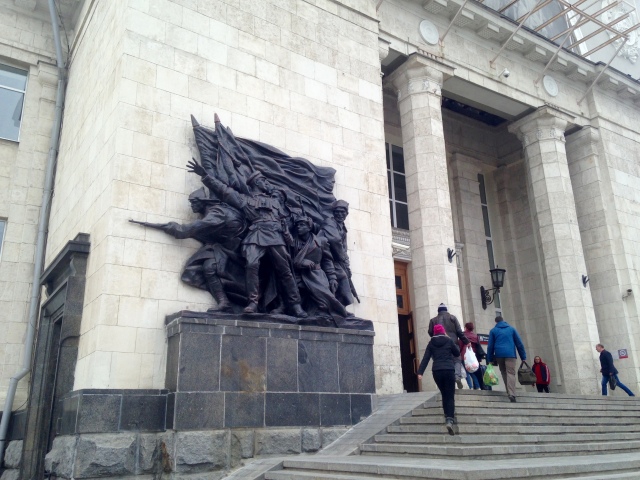
The memory of the War is still very fresh in many Russian’s minds. During my first stay in Russia, the film “Stalingrad” came out in theaters. It was the most expensive film ever made to date in Russia. I remember going to the film with my friend, Elberd. There is a scene in the movie about 15 minutes in, where Soviet troops are running up the west bank of the Volga. The Germans then blow up the oil reserves near the river, setting a blaze the embankment, alone with many of the Soviet soldiers. The surviving soldiers, run through the flames, and in patriotic zeal, overrun the German positions. The Russians in the theater yelled and cheered, “Die Fascists,” and “Go comrades.” IT really gave me a sense of how important this event in history is to Russians, let alone for the inhabits in Volgograd. The Battle of Stalingrad is one of the most famous battles fought during the Second World War or as the Russians call the conflict, the “Great Patriotic War.” It is marked by the constant close quarters combat, unstop air raids, the slaughter of civilians and is said to be by some scholars as the largest (nearly 2.2 million personal) and bloodiest (estimated between 1.7 to 3 million people killed or wounded both military and civilian) battle in human history. The losses inflicted on the German Wehrmacht make it arguably the most strategically decisive battle of the whole war and was the turning point on the Eastern Front as the German forces never regained the initiative in the East and withdrew a vast military force form the Western Front to replace their horrendous losses. Of the 77,000 German troops sent to fight in Stalingrad, only 3,000 some walked away, most as prisoners of war.
The German offensive to capture Stalingrad began on the late summer of 1942, the German 6th Army and elements of the 4th Panzer Army making up the bulk of their forces. The attack was supported by intensive carpet bombing of the city by the Luftwaffe and reduced Stalingrad to little but rubble. The German’s genocidal campaign on Russian civilians was for three purposes: the first to break Russian moral. The second being that Hitler hated the Slavs as much as he hated Jews. The Nazis left a bloody tail through Poland, into Ukraine and in much of Western Russia, looting and burning homes, hanging dissidents, and enslaving thousands of Slavs for “free” labor, many of them dying beside their Jewish peers in the camps. The third reason then being that the Nazi war machine needed the oil from the Caucasus and the Caspian Sea. Hitler is quoted saying that “If I do not get the oil in Maikop and Gronzy then I must liquidate this war.” It is said, that Hitler also wanted to break the Russian spirit through psychological means, by capturing “Stalin’s City” i.e. Stalingrad, the new industrial hub of the Soviet Union. This however, could be a Soviet tale, as German commanders are quoted saying that, “The capture of Stalingrad was subsidiary to the main aim. It was only of importance as a convenient place, in the bottleneck between Don and the Volga, where we could block an attack on our flank by Russian forces coming from the east. At the start, Stalingrad was no more then a name on a map to us.” – from Lloyd Clark’s Kursk: The Greatest Battle: The Eastern Front, 1943, 2011, page 157.
By mid-November of 1942, the Germans had pushed the Soviet defenders back, but at great cost, into narrow zones along of the west bank of the Volga River. On the 19th of November, the Red Army launched what was called Operation Uranus, a two-pronged attack targeting the weaker irregular forces of the German army, notably the Romanian and Hungarian forces protecting the German 6th Army’s flanks. It was interesting to learn at the Panorama Museum that so many ethnicities were recognized on both sides in the battle. The museum has an exhibit displaying the flags of Soviet regiments from the then Kazakh A.S.S.R., Korea, Vietnam (then French Indo-China), China, Japan, Poland and Czechoslovakia. The famous Soviet Field Marshal Georgi Zhukov, was responsible for much of the strategic planning in the Stalingrad region and is honored with many statues and memorials around the city. He is even buried on the grounds of Mamayev Kurgan. Operation Uranus was made in conjunction with Operation Mars, which directed attacks on the German center, engaging their forces on three fronts. The Soviet 1st Guards, the 5th Tank Army and the 21st Army led these assaults with support from the 18th infantry divisions, the 8th tank brigades, and the 6th cavalry. Thinly spread, deployed in exposed positions and poorly equipped for the harsh Russian winter, the Romanian 3rd Army and the German 6th Army was when surrounded and later overrun. The battle lasted for five months, one week and three days.
The fighting in Stalingrad was furious. German military doctrine was based on the idea of “combined-arms teams,” meaning cooperation between tank units, infantry, engineers, artillery and aerial bombardment. The Soviet commanders countered these tactics by always keeping their front-line positions as close to the Germans as possible, making aerial bombardment impossible unless the Germans wished to drop bombs on their own men (which sometimes happened). The Soviets called this “hugging” and it resulted in slowing the advance of German troops and made the infamous blitzkrieg useless. The Red Army held their ground as long as possible (enforcing this by keeping soldiers armed with sub-machines within the doorways of structures to shoot their own peers if they abandoned their posts out of cowardice), converting multi-floored apartment blocks, factories, warehouses, street corner residences and office buildings into a serious of defendable strongpoints of 5 to 10 man units. When a position was lost, an immediate attempt was made to re-take it with fresh forces. Bitter fighting raged for every ruin, street, factory, house, basement and staircase, some men fighting with their hands or bricks. The Germans called this Rattenkrieg or “Rat War,” as urban warfare of this scale was never seen before.
Some major points in the battle were on Mamayev Kurgan (or Mamayev Hill in English), a prominent hill above of the city. The fighting here was particularly brutal and merciless, as soldiers had to charge up the steep terrane and face an onslaught of bullets from machine guns. Ownership of the hill changed many times over the course of the battle. In another part of the city, a Soviet platoon under of command of Sergeant Yakov Pavlov, fortified a four-story building that oversaw a street near the west bank of the Volga River. The remains of this structure would later be called “Pavlov’s House.” The soldiers surrounded the building with mines and set up machine gun positions at the windows and breached the walls in the basement for better communications. The soldiers held their position for two mouths, without significant relief or reinforcement. The Germans called the building Festung or “Fortress.” The building was never taking by Nazi forces and Sergeant Pavlov was awarded the Medal of The Hero of the Soviet Union for his actions in defense of the city. The building still stands to this day, reminding the Russian people of the struggle. It has been labeled by the Russian government was a “Cultural Heritage Site.”
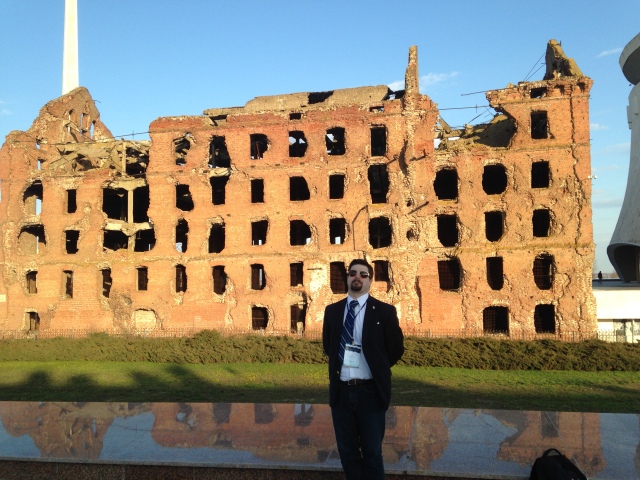
The legends of various snipers are also very important to Stalingrad lore and several films (notably, “Enemy at the Gates,” 2001 and “Stalingrad,” 1973) and video games (notably, “Call of Duty” and “Medal of Honor: European Assault”) have retold these various stories, highlighting the importance of the sniper and his or her role in the battle. In the the video game “Call of Duty,” the player fellows the story-line of a female-Soviet sniper during the Stalingrad campaign and personifies snipers such as Lydumila Pavlichenko, who is crediting with 309 kills and is regarded as the most successful female sniper in history. Snipers on both sides used the ruins of the city to hind, waiting for the right moment to inflict as many casualties as possible. The most famous Soviet sniper in Stalingrad was Captain Vasily Zaitsev, who is credited with 225 confirmed kills. Rumor has it what he and a German sniper, coined by the name of “Major Erwin König (another name of this same sniper was Heinz Thorvald),” were locked in an epic contest that has been immortalized in numerous novels and films. In his autobiography, “Notes of a Russian Sniper,” Zaitsev describes how he carefully studied the battlefield until he finally baited a trap for König.
“Kulikov fires off a blind shot. We have to arouse the sniper’s interest. We decide to sit out the first half of the day; light reflecting from the scopes could give us away. In the afternoon our rifles are in the shade while the direct light of the sun falls upon the German’s position. Something sparkles by the edge of the sheet. Is this a piece of glass that just happens to be there, or is the telescopic sight of a sniper’s rifle? Very carefully, as only the most experienced sniper would do, Kulikov starts to raise a helmet. The German fires. Kulikov raises himself for a brief moment, shouts loudly and falls. The German sticks half of his head out from under the sheet. I fire. The German’s head sinks, and the optical sight of his rifle sparkles in the sunlight.” – Notes of a Russian Sniper, Vasliy Zaitsev.
Although this is a great story and undoubtably there were snipers fighting during the battle, it is just a legend. According to British historian Frank Ellis in his book, The Stalingrad Cauldron (2013), there is no record of a “master sniper” named König within the German military achieves. Zaitsev did indeed shot a sniper that day, not it is unlikely that this epic dual ever took place. However, this should not diminish the importance of the Soviet snipers as they were used often during the battle and there are many records of such encounters. German records are subsequently, filled with complaints from both soldiers and officers about moving out of their trenches only to risk their lives to sniper fire; Soviet snipers emphasizing the targeting for offices and working their way down the ranks. The various museums in the city display a lot of this information and it was so cool to be in a city that I had read and heard so much about.
After arrived at the train station, we waiting for my friend Pierre to pick us up. Pierre is a friend of mine from my first year in Pyatigorsk. He current lives in Volgograd, working as a teacher of French at one of the smaller universities in the city. It was so good to see him. I had missed our long conversations together about France and America, as well as about political happenings in the world. All of these would happen with glasses of beer. Pierre is from the Britney region in France and they have a huge beer culture there. We visited several bars and pubs while in the city and I tried a few Belgium and French brews that Pierre recommended to me. There as an interesting and taste Belgium brew called “Kwak” and it was served in strange, hour-glass like shape with a narrow neck and a ball-bus bottom. The “Kwak” has a wonderful favorite, with a very strong, fruity finish. I had this beer at “Alyaska Bar,” a popular pub in Volgograd. It was like a “Hipster Bar” in a way, as the bar keeps both had thick, bushy beards, wore thick glasses and bow ties. The beer was good and the prices were reasonable for foreign brews.
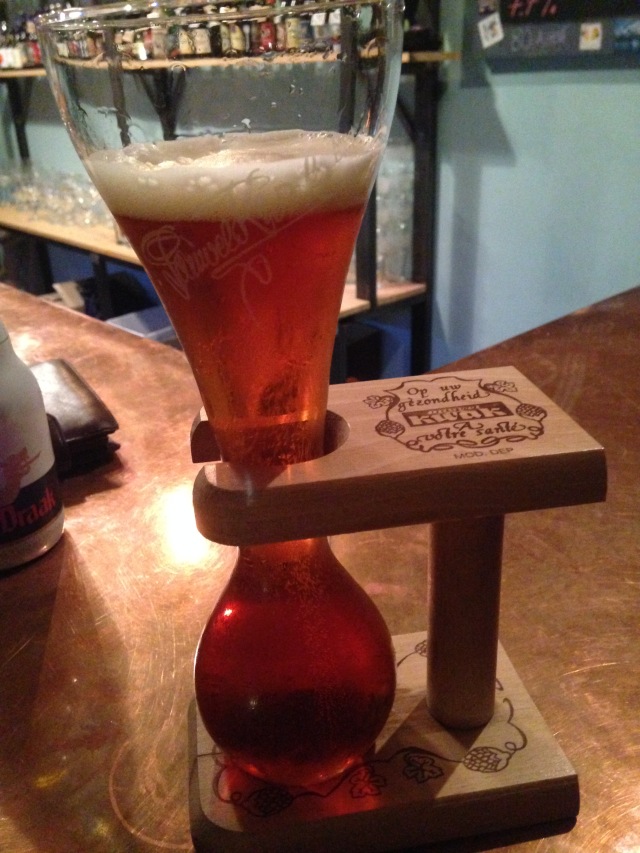
Pierre also showed us a few monuments in the city, notably Mamayev Kurgan. At the base of the hill (kurgan) there is a series of stairs letting up to a plateau of stone that has a huge sculpture of Soviet soldier, with a defiant expression on this face, holding a PPsh-41 (a Soviet sub-machine gun). He is shirtless and he build personifies the “prefect Soviet-man.” A fountain surrounds him like a moat and would be working when the weather gets warmer. Past our noble soldier, we then headed up a another series of stairs to another sculpture. It was split into two parts, flanking either side of the stairway and depicted Soviet soldiers battling the Germans. The stone walls that the sculptures are curved upon are from the old Nazi fortifications that were built on the hill. I touched the rock, getting a sense of the history that had gone on here 73 years ago. It was an amazing sensation. We then head up yet another stair way and entered the Hall of the Eternal Flame. It was a magnificent sight to see and the atmosphere was that of a church. When you step inside, you see a stark white sculpture of a hand grasping a torch. It must stand at least 20 to 30 feet high. A brilliant flame burns from the torch. The hall is a circular structure and around it’s walls are the names of thousand of Soviet soldiers who gave their lives in defense of Stalingrad. It was a very sobering moment to see all the names. As we exited we saw the statue of Mother Russia standing tall and proud, with a sword in her hand. The memorial was build between 1959 and 1967 and is totally made of concrete, except for the sword blade which is stain-less steel. The statue reminds me of the Greek representations of Nike, with her flowing drapery. The statue stands 52 meters tall (170 feet) and is 82 meters from the feet to the point of the sword (269 feet), making it taller then the Statue of Liberty in New York City. The official title of the monument is The Motherland Calls, and it was designed by Yevgney Vucheitch. Vasily Zaitsev is also buried here. On the grounds of this hollowed place, it is still possible to find fragments of bone and metal still buried throughout the hill. There are also a series of graveyards on the hill, many of which lack names.
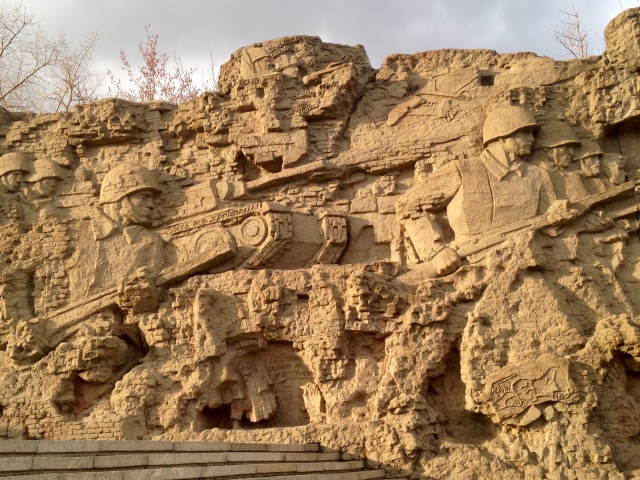
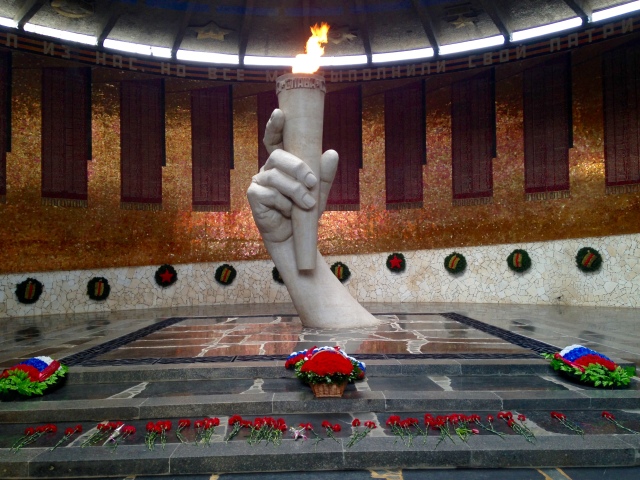
Diogo and I then shared a few glasses of beer with Pierre after our tour and returned to our hostel. It was convenient that our hostel was located near the Mamayev Kurgan, but inconvenient in that it was very far away from the University. We got a good night sleep and headed to the University at around 9:15 in order to make it in time for registration between 10:30 and 11:00. It takes about an hour to get to there by marshot and it made me appreciate the morning rush and battle to get to work everyday that million of people around the world have to go through while living in big cities (Volgograd is a metropolis of 3 million and is 40 miles wide). It was difficult during some morning to even find a seat on the marshots as many were stuffed with people. The streets in Volgograd and also very muddy and the dust and car exhaust make breathing a difficult. They are also a lot of industrial complex shattered throughout the city and one can imagine all of the pollution that one is breathing from these factories. It made me miss the clean mountain air of the Caucasus very quickly. It took about an hour to get back and forth from the hostel to the University. The the air was so bad that the first day into our stay, I developed a rash on my face that dried out my skin to the point where my cheeks cracked a bled. But, needless to say, the trip was worth it.
Volgograd State University is on the edge of town, on a hill, over looking the Volga. The University itself is not much to look at, but it serves its purpose. We walked up the hill (a task in of itself) and entered the main library where registration was to begin. We then got all of our materials, including our name tags, delegate cards with our countries names on them, and our folder with all of our paper s and notebooks. We met our fellow delegates within our various committees. Diogo was in the International Court of Justice and their topic was the genocide in Rwanda. The working language of his committee was in French, so it was perfect for him to practice his fourth language. His also represented his native country of Brazil. There was also the committee of Economics, in which the working language was Russian and I my committee was the Secuity Council. I represented the nation of Uruguay and our topic was on the relationship between Iran and Saudi Arabia, a very relevant topic in regards to the current geopolitical situation. I enjoy that these last two Model UN’s have been very useful when discussing the various happening in the world. The working language of the Secuity Council is English, but to be honest my peers spoke Russian on a daily basis and the working language may as well have been Russo-English. On the first day, we had open committee, just to review the rules and procedures. We also did a mock session, the topic of which was “legalizing prostitution.” This made we laugh and made most of the delegates very uncomfortable. Representing Uruguay, of course my nation was for the legalization of prostitution as Uruguay has legalized almost everything else. The delegate of Ukraine was also for the legalization and I asked him whether or not his government would be willing to put a “premium” on Ukraine women as the world knows they’re very beautiful. The room started laughing the delegate was speechless. One must be on their toes at all times when in these negotiations.
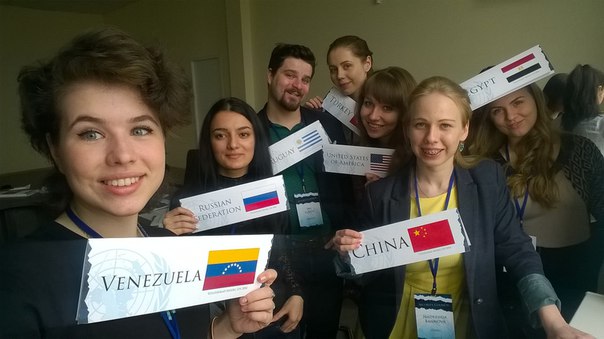
That evening, Angelina and the other heads of the Volgograd International Relations faculty brought us on a bus tour of Volgograd. We stopped by the theater and the train station, as well as one of the city squares. It had an eternal flame memorial. This place is also famous for a tree that is the only surviving tree from battle 73 years ago. It is literally a living witness to history. It also looking the part as its appearance is ancient with its gnarled trunk and finger like limbs. There is also a memorial to all the foreign fighters who fought in defense of the city, notably to Spanish Communists who fled to the Soviet Union after the Spanish Civil War. We then got back on our bus and headed to the western bank of the Volga where we saw “Pavlov’s House,” yet another sobering moment. We of course took a lot of photos and I was introduced to the student journalists who were covering the Model UN. I thought it was very cool that journalism majors were assigned to report on the happenings both inside and outside on committee and it gave a new element of “live reporting,” seeing articles pop up in the Volgograd Model UN’s website and VK page. The networks represented were CNN, Russian Today (RT) and Euronews. It was very similar to the news networks that we established at Hastings during my senior year Global Summit. I loved this idea and it was nice to see it in practice here at Volgograd State University.
The second day was the longest, as we had committee starting a 9 o’clock in the morning. We started by listening to all of our fellow delegates speeches regarding their individual nations stance on the relationships between Iran and Saudi Arabia. It was interesting to hear all the speeches and it think about how consistent they were with the actual positions of their nations. The delegate from Ukraine was one of the most entertaining individuals in the whole committee. It his speech, he got side tracked after and question from the delegate from Spain who asked him if “borscht and salo” were Russian or Ukraine dishes, after he said that Ukraine would counter terrorism and extremism by exporting Ukrainian culture. I then responded by saying, “How are Ukraine export its culture in the Middle East if Muslims can’t eat salo?” Laughter then ensued and it all fell apart, the Presidium calling us all to order (Ukraine also is the “problem child” in this events). Questions were frequent and it was very good to have most delegates actively engage in debate and confront their peers based on policy differences. It was very interesting to see how the coalitions formed. Uruguay is a very neutral nation and I allied myself with regional partners including the Venezuela was it made sense. The hardest challenge was to find ways to maintain my nations trade deals with Iran, while staying buddy, buddy with the global powers and my regional allies.
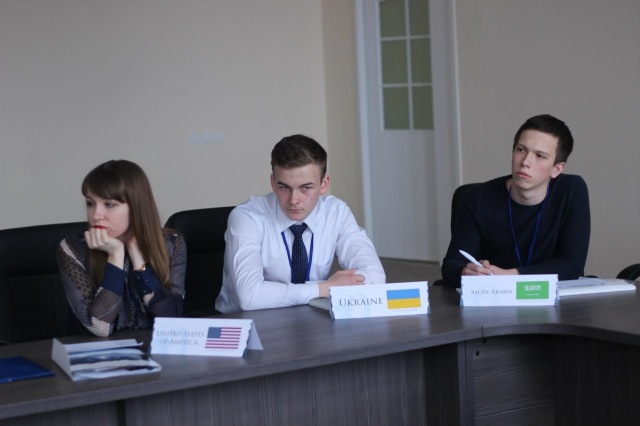
The second day was a mix of more speeches from the delegates (it took forever to get through all the opinions from each nation) and coalition building. It was very strange to see the United States, the Russian Federation, and China working together in a coalition that including myself, and several of the smaller players including Venezuela and Egypt. The second coalition was ever stranger with Iran and Saudi Arabia working together, along side of France and the UK. It made us all question the situation and what was going on. We then spent most of the time debating back and forth from calling both Iran and Saudi Arabia out on this unrealistic alliance and myself and my fellow delegates from our coalition gave several speeches on the matter. The third day was then spent on framing ideas for a resolution and we started writing. It main points in our working paper were concerning with economic incentives and nonintervention, while maintaining the standards of international law and past resolutions on the subject. We also emphasized the Group 77 of which Iran is a member, could help open a venue for starting dialogue and that Sunni and Shia leaders must work together at the grass roots to route our extremist elements within their communities.
After the resolutions were presented buy both groups, their was more debate on the various points and good work was being done on finding some common ground. It was still very difficult as the UK vetoed our resolution and China, the U.S. and Russia vetoed theirs. After this, we were at a stale mate. The fourth day was the most intense for the debates, were we need to persuade the opposite coalition to agree with ours. I gave a speech on the fact that Iran needed to be checked on its commitment to the international community and that only through mutual cooperation by member of the Secuity Council could goals be made. In the end, France and the UK backed us and Iran even caved, making the whole event a “done deal.” I was very impressed by the commitment and effort that my fellow delegates put into the conference, especially for some of my peers who were at Model UN for the first time. It was also great to learn about them as people. I really got to know more about them at the dinner we had for all the delegates on the third night. There was good food and champagne, the tradition of toasts was alive and well. There was also dancing. I was evening asked to dance lezginka by Angelina, so we dance lezginka together and it was a hit amongst my peers. We had a very good time and I’m so glad that Diogo and I got to met so many people, connections that will serve us well in life.
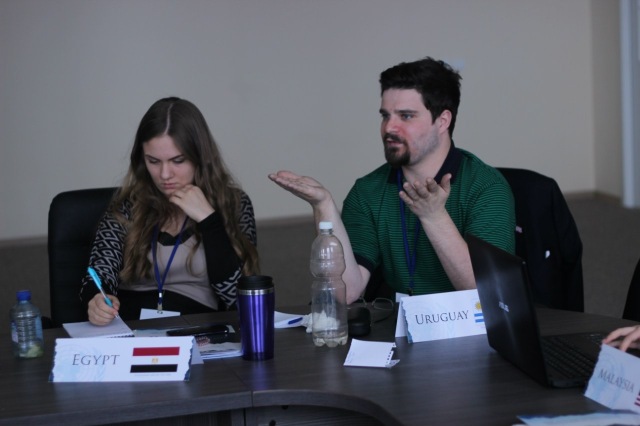
At the end of the conference, we had an award ceremony. I was awarded the Best Delegate Award again. I honestly was shocked because these things rarely happen twice. I’m so thankful for the experience of both participating in this conference and also to see the famous city on the Volga. Diogo and I returned to Pyatigorsk with a set of new experiences, good memories and we made a lot of people. I can say though that I’m happy now to have a break for conferences and traveling. Well, friends I hope you are all well and doing fine. Chat with you later. From Russian with regards.

